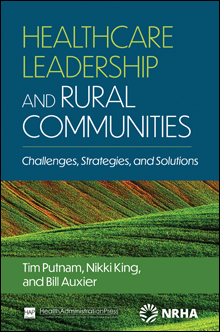Editor’s Note: This content has been excerpted from the book Healthcare Leadership and Rural Communities: Challenges, Strategies, and Solutions. The content has been edited down for length.
Every community has its patchwork of healthcare providers. The services of each may be limited in scope and scale, but when they forge solid working relationships and partnerships, they play an effective role in advancing the health of their community.
Most small organizations are experiencing more financial pressures and are far less abundant than just a few decades ago. Independent physicians, dental practices, pharmacies, emergency medical services providers and long-term care facilities are joining larger organizations to remain viable. This shift leads to less local control and leadership involvement in the community. When decisions cannot be made locally, synergistic and lasting relationships are harder to create. Still, those relationships are necessary to achieve continuity of care as patients interact with a succession of local providers.
Long-Term Care Facilities
Long-term care facilities are seeing more medically frail patients now than in years past. The growth of assisted living services and coordinated in-home care has given more options to people with fewer complex conditions. As a result, they are dealing with residents who require more frequent interactions with acute healthcare facilities.
The best hospitals recognize this trend and work to ease the transfer of patients. Much can be done to improve this process through telehealth consults, improved monitoring and interventions at the LTC facility. Unfortunately, financial incentives do not align with such services and collaborations. As a frequent result, the residents are just shuttled to the ED or other care facility for care. Steps should be taken to provide more care for the residents where they live at the LTC facility and reduce the number of times it is necessary to transport them to another location.
Emergency Medical Services
The capabilities of emergency medical services have advanced dramatically in recent years. However, the advent of highly trained professional EMTs and paramedics who complete continuing education classes and continually practice has made the rural model of volunteer EMS more expensive. Because there is just not enough 911 call volume in low-population densities to fund these services through billable charges, only three options are left.
- EMS must be subsidized by sources such as tax revenue, grant funds and the local healthcare system.
- Partnerships can be developed to provide regional EMS responses.
- Large service areas can be created by one EMS agency to get the patient volume necessary for financial viability.
Independent Physicians, Dentists, Allied Healthcare Providers
Independent physicians interact with patients of the local hospital but may not be on staff or associated with it in any other way. Making it easy for them to know how to access a hospital’s acute care services, getting reports of their patient’s care at the hospital back to them promptly, and communicating any changes in hospital services will engage all providers in the local healthcare system.
Dentists exert a significant impact on the health of a community. Dentists in rural areas are typically not available 24/7, so their patients with acute needs (who may lack the ability to pay for dental care) end up in the local hospital’s ED. In this scenario, there is precious little interaction between the provider and the hospital.
As healthcare continues to emphasize the prevention of disease in the transition from volume to value, interaction among all health professionals is crucial. Rural hospital leaders can bridge this gap by involving allied healthcare professionals in conversations whenever possible. The ability to coordinate care with these providers is relatively easy to develop in small communities, given the limited population size and frequency of interactions. However, it will take leaders with vision and the willingness to work outside of their organization’s walls to pursue these vital relationships and develop a true healthcare system.
Pharmacies
National chains now make up the vast majority of pharmacies. The local store managers may have limited ability to function independently, as major decisions are generally made at the corporate level. This makes it difficult to create partnerships. Nevertheless, pharmacists are a key part of the healthcare system. A good rapport with pharmacists can help hospitals understand what is working and not working from the patient’s perspective.
Like Organizations in Nearby Communities
There may be some local people who will sing the praises of the “vastly superior” quality of care they received as patients in the other town’s hospital. Even hospital board members share stories at board meetings about their neighbor who sees a physician in the competing community and then try to steer the strategic plan toward competing against the other community. This can lead to launching negative ad campaigns or recruiting staff from the other community. Such actions create far more animosity than any benefits.
Working together on joint recruitment, shared services, quality initiatives and the development of best practices can yield far more benefits than fighting over volume. Good leaders need to work through urges to compete with the neighboring town and instead engage in honest conversations that can identify opportunities where both organizations can advance the health of their communities.
Timothy L. Putnam, PhD, FACHE, is president/CEO, Rural Health Consulting.

